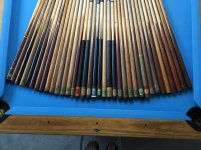Thanks very much for all the info & help gang. In case anyone else is interested, it seems the first cue, the engraved one that I thought might be a Sampaio - is most likely either a german Boeztel or french Hiolle carom cue. It has attributes of both, hard to say...
For the double butterfly (middle cue in pics), found this
thread, which features some cues with almost identical points & joints. Seems BW made carom cues like these themselves & via 3rd party contracts that looked like this, could be Rieper, Oliver Briggs, Luscher, or Katz... Apparently these come up from time to time, and are very difficult to precisely ID - as I’m clearly discovering!
Way too time consuming for me to dig further, but if anyone has other leads that could help narrow down my mystery cues, I’m all ears.
Thanks & cheers

